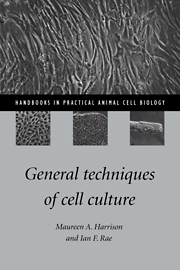2 - Equipment
Published online by Cambridge University Press: 02 February 2010
Summary
In its broadest definition, equipment includes the laboratory in which cell culture work is undertaken. Some are fortunate enough to occupy purposebuilt cell culture facilities but many use existing laboratories which require varying degrees of adaption to house a successful cell culture area. When planning a laboratory for cell culture, six main functions have to be accommodated. These can be neatly divided into two main groups: sterile handling and support services. Sterile handling includes a cell culture and manipulation area which should be adjacent to an incubation and a storage area. Support services include washing-up, preparation (repackaging) and sterilization. These three functions should also be adjacent to each other and provision made to extract the large amounts of heat and steam associated with this type of operation. It is not essential for the services to be adjacent to the sterile handling area but they should be within the same building. By far the most important consideration is to minimize the chances of microbiological contamination of cell cultures. One of the main causes of contamination can be sudden draughts of room air crossing the work surface from opening doors, the passage of staff behind the operator, open windows or wall-mounted air-conditioning units. Where a laboratory has opening windows, it is vital they are kept closed whenever cell culture work is in operation. Wall–mounted air-conditioning units have no place in a cell culture laboratory because the damp internal conditions harbour and support a source of microbiological contamination readily circulated by the forced movement of air from the unit.
- Type
- Chapter
- Information
- General Techniques of Cell Culture , pp. 7 - 30Publisher: Cambridge University PressPrint publication year: 1997
- 3
- Cited by

